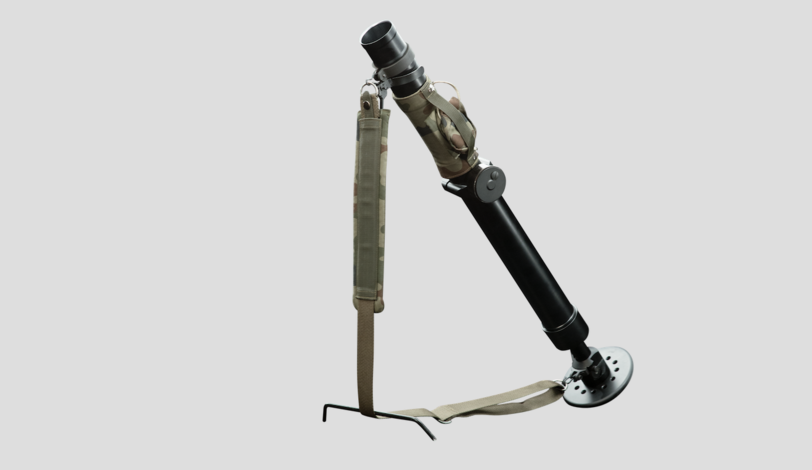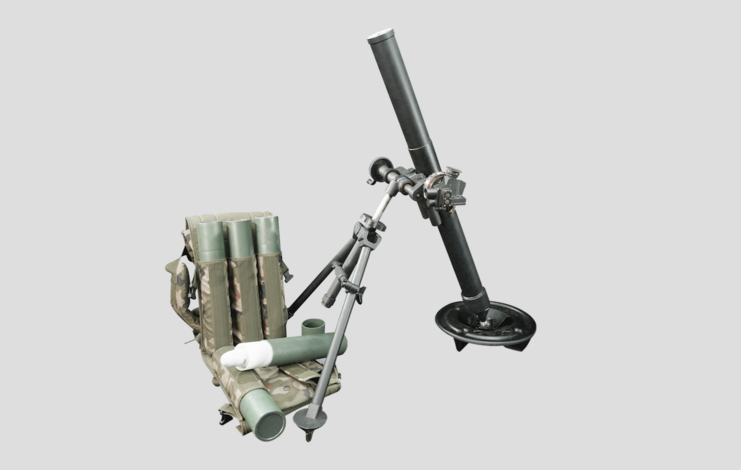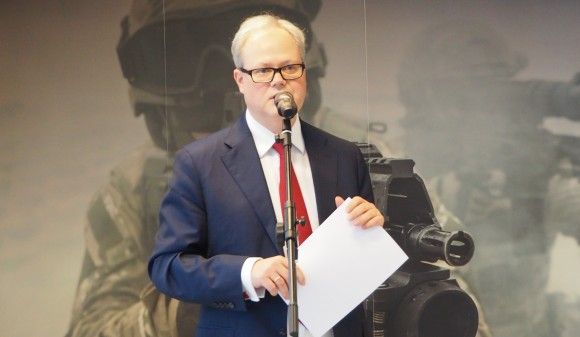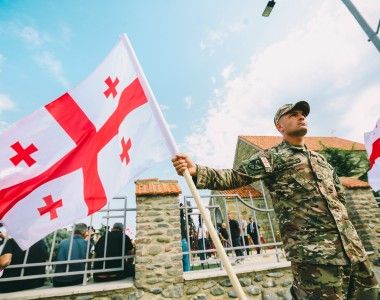Light Polish LM-60 Mortars
Considering the numerous questions referring to the light Polish 60 mm mortars, I would like to, within the article below, present this unappreciated weapon in a different manner, pointing to the basic features of the said system that may be of benefit on the contemporary battlefield – as Adam Henczel’s MSc article for Defence24.pl reads. Henczel is working as a Product Manager at the ZM Tarnów company, and between 1994 and 1998 he was acting as the Chief of Artillery of the 1st Light Air Cavalry Regiment of the 25th Air Cavalry Division.
Referring to its encyclopedic definition, artillery term may be associated with any firearm having a calibre exceeding 20 millimetres, shooting explosive rounds of a variety of types. Below that limit, we are dealing with small arms. The weaponry in question is destined to be used against the enemy infantry, vehicles, and to destroy infrastructure, fortifications and defensive structures remaining in control of the adversary. Considering its tactical use, artillery may be divided into cannons, howitzers, gun-howitzers, mortars, recoilless rifles and other artillery assets.
Here, I would like to refer to the fact that our light LM-60D (long range) and LM-60K “Commando” mortars belong to the artillery group of ordnance. This means should we be placing them in any context different from the above, this shall be viewed as ignoring the technical definitions, and may be seen as a symptom of a lack of knowledge on the subject.
READ MORE: Pro Defense 2017: Mortars, Rifles and Multiple Grenade Launcher Offered by ZM Tarnów
After I got acquainted with the available sources of information on the 60 mm mortars, most of the materials covering the advantages offered by this type of weapon were, and still are being published in the US media.
Hence, numerous question emerge:
-
What drives the US military experts to describe the weapon in this way?
-
Why armed forces so modern and rich are not inclined to resign from the 60 mm mortar, continuously modernizing it instead.
It seems that the role ascribed to this weapon by the US soldiers may be a reason.
1. In assault:
-
Immediate support when responding to direct enemy fire,
-
Provision of conditions required to hamper the manoeuvrers undertaken by the enemy to begin a counter-attack,
-
Inflicting losses on the enemy that would, at least for some time, render him incapable and effectively hamper or make it impossible for the adversary to carry out any movement,
-
Acting against weaponry which may pose a direct threat to the attacker.
2. In defensive context:
-
Scattering the attacking enemy assets,
-
Limiting the mobility within the area that is being taken over, forcing the enemy to move to the area under direct fire of own forces,
-
Interrupting the synchronization of the actions undertaken by the enemy, in conjunction with other assets utilized by own forces,
-
Acting against command and firing positions, including artillery offering direct support for the attacker.
The US strategy analysts suggest that carrying out a manoeuvrer which would win the fight requires indirect fire to be used. The mortars are a weapon providing this very type of fire, with invaluable high angle of fire, that could be used against enemy using fortified and unfortified positions that are not exposed to direct strikes.
Summing up, using the mortars allows own forces to take over the initiative, closing down and destroying the enemy in the specific area, or avoiding the enemy and hitting the enemy forces elsewhere. The mortars, are embedded within the whole fire support system at the level of the infantry element, allowing the commanders to carry out specific tasks.
There is one more factor listed by the Americans, supporting maintenance and modernization of the 60 mm M224 mortar: the economy. The weapon in question is cheap and highly effective. It is a perfect support solution in urbanized and mountainous areas, which has been proven by numerous documentaries and battle experiences gathered by the forces fighting in Iraq and Afghanistan.
Even though the M224 60 mm mortar is a derivative of the World War II M2 weapon, LM-60-D mortars made in Poland have been created to meet the requirements of the air-mobile units, and LM-60K weapon has been designed to fit the needs of the airborne elements, getting rid of the obsolete 82 mm post-soviet Type 1943 mortar.

The initial design assumptions included:
1. Design assumptions adopted in case of the LM-60D unit for the mixed artillery battery (9 mortars and 8 9K111 ATGM launchers):
-
Weight which would not exceed 21 kilograms (82 mm mortar weight was close to 58 kilograms);
-
Option of carrying a folded mortar on a backpack-like frame by a single soldier;
-
Effective range of 2300 meters;
-
3-man crew (gunner, loader and ammo supplier).
2. Design assumptions adopted in case of the LM-60K unit for an assault squad (1 mortar):
-
Weight that would not exceed 8 kilograms;
-
Having an option of the mortar being carried by a single soldier;
-
Effective range of 1300 meters;
-
Elevation range of 5°÷85°;
-
2-man crew (gunner, service);
-
Design making it possible for the mortar to be used by a soldier who is not an artillery specialist.
Back in 1991, a team of designers of the Research and Development Centre for Mechanical equipment from Tarnów, led by the design-team head, began works on developing light LM 60-D and LM-60-K mortars. 60 mm has been defined as the barrel calibre, with 59.4 mm ammunition.
Considering the parallel works carried out simultaneously by OBR SM Tarnów, OBR „Skarżysko Kamienna”, Huta Stalowa Wola and the Military Institute of Armament Technology based in Zielonka, implementation work performance tender was announced back in 1998. OBR SM Tarnów won the tender. Implementation work has seen production of 6 LM-60D and 3 LM-60K mortars.
Moreover, wide handing-off test programme has been carried out, with regards to the mortar’s lifecycle. A single unit of each of the mortar types has been used to fire 1500 mortar rounds. The test programme had positive results in the end. Back in the year 1999, an agreement has been signed to deliver 18 LM-60D mortar kits.
Following the No. 195 order issued by the Chief of the Polish Army’s General Staff on Aug. 2nd 2000, new generation of equipment has been introduced into use in the Polish Army, including 60 mm LM-60D and LM-60K mortar systems. OBR SM Tarnów facility has received an invitation letter to participate in a limited tendering procedure, delivering the first 27 mortar systems.

Back in the year 2003, a proposal has been rejected by the Commander of the Land Forces to change the barrel calibre to 60.7 mm. As of 2012, the mortars have been manufactured at the ZM Tarnów S.A. facility. More than 500 examples have been delivered up until now.
In the year 2014, as a response to the foreign customer’s requirements, 2 LM-61K “Commando” short barrel mortars have been manufactured, with 60.7 mm calibre, along with a batch of ammunition manufactured in line with the agreement concluded by Zakłady Metalowe Dezamet S.A. At the same time, LM-60D mortar featuring a 1000 mm long barrel was tested, with range being extended by one kilometer, in comparison with the previous variant (barrel length of 865 mm).
Moreover, one shall also recall the fact that the OBR R&D facility has developed a composite barrel Commando LM-60KC system (barrel made out of aluminium alloy and a carbon fibre sleeve). The aforesaid mortar also went through the qualification test programme, which turned out to be successful, and now it may be manufactured.

Summing it up, 60 mm mortars offered by the Polish ZM Tarnów Company are not a treaty product, meaning that they do not expose the Army to expenditure related to acquisition of ammunition on foreign markets.
As I have mentioned it above, LM-60D and LM-60K design has been tailored for being used with the domestically manufactured ammunition and vice-versa. The interest in Polish mortars on the foreign markets forced the ZM Tarnów facility to develop the product and meet the requirements of the new orders, also within the scope of manufacturing cal. 60.7 mm barrels. Similar steps have also been made by the Dezamet S.A. company which, resigning from waiting for the decision made by the Polish MoD, has prepared yet another batch of NATO-compliant fragmentation rounds.
Adam Henczel MSc is working as a Product Manager at the ZM Tarnów company, and between 1994 and 1998 he was acting as the Chief of Artillery of the 1st Light Air Cavalry Regiment of the 25th Air Cavalry Division.






